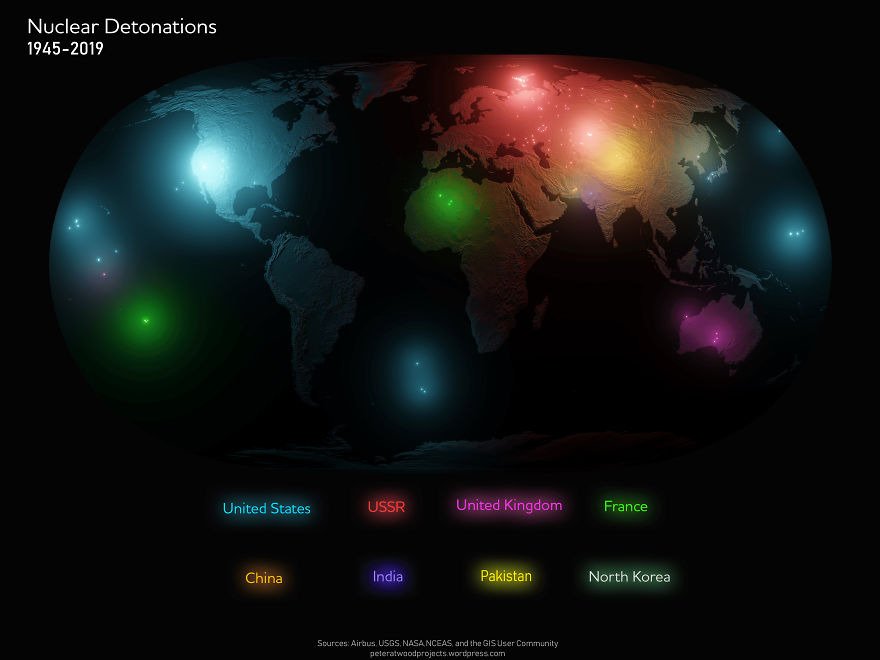On July 16, 1945, the first nuclear bomb exploded in the New Mexico desert and changed history forever. In a flash, the world entered the nuclear age. In the 74 years since that first test, there have been more than two thousand nuclear explosions around the world, carried out by eight countries. It can be hard to get a sense of the global scale and impact that these explosions have had. To get a better idea, I made a series of maps which show every explosion as a point of light illuminating a 3D landscape, with each color representing a different country.
More info: peteratwoodprojects.wordpress.com | twitter.com
The World

Looking at a world map, we can see the global scale of nuclear testing with explosions occurring on every continent except for South America and Antarctica. The vast majority of nuclear tests were carried out by just two countries: the United States and the USSR. To get a better idea of where these tests were carried out, we need to take a closer look at some of the brightest parts of the map.
Nevada Test Site, United States

The site of the largest number of nuclear explosions on Earth was the Nevada Test Site in the southwestern United States around 130 km (80 mi) from Las Vegas. A total of 928 tests occurred there from 1951-1992. Even though the site was located in the desert, the effects of the tests were felt far away. Tourists in Las Vegas could see mushroom clouds rising over the desert from their hotel rooms.
In 1962, the Sedan test produced an enormous cloud of radioactive dust that was carried by the wind across the United States and resulted in increased levels of radioactivity as far away as Chicago. On the map, you can also see the 24 British tests that were carried out at the Nevada Test Site in cooperation with the United States.
Pacific Proving Ground, Marshall Islands

Some nuclear tests were too large and too dangerous to be performed at the Nevada Test Site. Instead, they were done in the Pacific Proving Ground in the Marshall Islands, an American territory in the South Pacific. The US carried out 106 tests here spread across several atolls (small island chains). These tests included the first hydrogen bomb tests and Castle Bravo, the largest nuclear bomb ever tested by the United States with a yield of 15 megatons, 1000 times larger than the atomic bomb dropped on Hiroshima. Some of these tests released radioactive fallout on the people who lived around the islands and fishing boats working in the area causing health problems that are still felt today.
Semipalatinsk Test Site, Kazakhstan

The largest Soviet test site was Semipalatinsk, code-named ‘The Polygon’, in present-day Kazakhstan. 456 tests occurred here starting with the USSR’s first nuclear weapon in 1949 and continuing until 1991 when the Soviet Union broke apart and Kazakhstan became independent.
Today, the Semipalatinsk Test Site is used by scientists studying the long term effects of nuclear weapons and is even open to the public for tours.
Novaya Zemlya Test Site, Russia

The USSR’s secondary test site was located on the Novaya Zemlya archipelago in the Arctic Ocean. 224 tests occurred here including the most powerful nuclear weapon ever detonated, the Tsar Bomba, with a yield of 50 megatons, more than three times as powerful as the largest American bomb and 3000 times as powerful as the atomic bomb dropped on Hiroshima.
French Polynesia

It might surprise you to learn that after the United States and the USSR, the country responsible for the most nuclear explosions is France. France tested 217 nuclear devices between 1960 and 1996. Most of these tests were carried out in French Polynesia in the South Pacific, while a few others were tested in Algeria in North Africa.
Like the American tests in the Pacific, the French tests have impacted the health of people living on the islands, with the local government pressuring France to pay for the cleanup of the site and ongoing treatment for the people who were affected.
Lop Nur Nuclear Weapons Test Base, China

The Chinese government carried out 45 tests at the Lop Nur facility in Northern China between 1964 and 1996. In 2009, a study suggested that the radiation from these tests may have been responsible for thousands of deaths in the towns and cities surrounding the site.
UK Test Site, Australia

In addition to the tests they conducted in the United States, the British government also conducted tests in the Australian Outback between 1952 and 1957.
These test sites were so isolated that for some Aboriginal people living in the outback, the first encounter they ever had with modern technology was when they witnessed a nuclear explosion.
India/Pakistan Tests

Both India and Pakistan have tested six nuclear devices. Although they haven’t tested nearly as many weapons as the other countries on this list, many experts believe that the border between India and Pakistan is the world’s most dangerous nuclear “hotspot”.
The border has been the site of conflict for more than seventy years and with both countries possessing nuclear weapons and long-range missiles, many fear that a large scale conflict between the two countries could lead to disaster.
Punggye-ri Nuclear Test Site, North Korea

The most recent country to develop nuclear weapons was North Korea, who tested their first bomb in 2006. Since then, there have been a total of six nuclear tests in the country at the Punggye-ri Nuclear Test Site. Since the last and largest test in 2017, the North Korean government announced that it would shut down the test site in order to ease global tension.
from Bored Panda https://ift.tt/309wsD6
via IFTTT